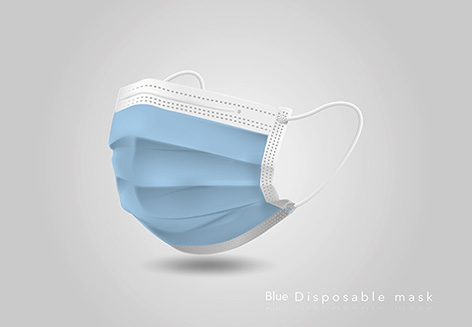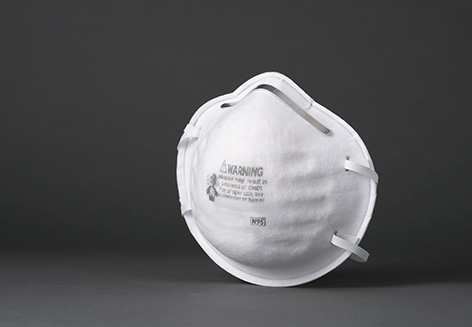ASOURCE®NAVI

公開日:2020.09.28
追記(2021.6.18):2021年6月16日に、一般用マスク、医療用マスク、感染対策医療用マスクに関する日本産業規格(JIS)が制定されました。新型コロナウイルス(COVID-19)感染拡大とともに、マスクの着用が強く推奨されており、日常生活にも医療従事者の皆様にも欠かせないものとなったため、マスクの性能及び試験方法について規格化、標準化を図ることで、使用者が安心して購入できるよう、医療用及び一般用のマスクを対象としたJIS T9001(医療用マスク及び一般用マスクの性能要件及び試験方法)、コロナ感染対策に従事する医療従事者用のマスクを対象としたJIS T9002(感染対策医療用マスクの性能要件及び試験方法)が制定されました。
日本で流通している医療用マスクには、サージカルマスク、N95レスピレーター、サージカルN95レスピレーター、KN95があります。

医療従事者や患者を感染から守るために、微粒子やウイルスなどの放出や侵入を防ぐ、血液や体液の飛散から保護する目的で使用されるマスクです。素材は不織布で、家庭用と比べて非常にフィルターの目が細かいのが特徴です。しかし、日本の医療用マスクには規格がないため、米国のASTM International(国際標準化・規格設定機関)の定める規格に基づいた製品が多くなっています。
ASTM-F2100-19(医療用マスク米国規格)に基づいた製品は5μm程度の飛沫を除去することができますが、細菌やウイルスはそれよりも小さいため、マスクを通過してしまうリスクがあります。しかし、実際に飛散される際には粒子の周りに水分を含んだ直径約5μmの飛沫となっているため、サージカルマスクによって感染のリスクを軽減することが可能です。

結核菌、麻疹、水痘ウイルスのように直径5μm以下で空気感染が懸念される感染症については、N95レスピレーターが有効です。
N95レスピレーターとは、米国労働安全衛生研究所(NIOSH:National Institute for Occupational Safety and Health)のN95規格を満たし、認可されたマスクです。欧米では、マスクというより「呼吸器防護具」としてレスピレーターと呼ばれています。その規格は、フィルターで最も捕集しづらい「0.3μmの粒子」を95%以上捕集できなければ認められない厳しいものです。粒子状の物質の吸入防止のために用いられており、元々は製造現場等で使用されていましたが、結核やSARSの感染防止に効果が認められ、医療現場でも積極的に用いられるようになりました。使用にあたっては正しい装着をする必要があり、息の漏れが無いかを確認するシールチェックは、着用の度に行います。
米国の医療機器などの認証を行う米国食品医薬品局(FDA:Food and Drug Administration of the United States Department of Health and Human Service) が承認しているマスクで、米国では医療機器として認められています。N95レスピレーターの基準に加え、液体防護性と延燃性の基準を満たしています。
中国国家安全生産監督管理総局(SAWS)が検査をし、米国におけるN95規格と同様の基準とされるGB2626-2006規格をクリアしたマスクで、そのうちGB19083‐2010の番号があるものが、医療用規格です。
アメリカでは、当初、米国食品医薬品局(FDA)がその有効性を認めていませんでしたが、2020年のCOVID19の感染拡大で、米国疾病対策センター(CDC)が、N95の供給が不足した場合、KN95が適切な代用品になるという見解を示しました。それに続き、米国食品医薬品局(FDA)でも、一定の基準を満たせば使用を承認する方針を明らかにして、保健衛生の現場で使われるようになりました。
これに続き2020年4月10日には、日本の厚生労働省でも「KN95などの医療用マスクのうち、米国 FDA で緊急使用承認(EUA)が与えられているものについては、N95に相当するものとして取り扱うこと」としています。
しかしその後、米国疾病対策センター(CDC)の下部組織である米国労働安全衛生研究所(NIOSH:National Institute of Occupational Safety and Health)の行った性能評価で、正当なメーカー製でもその多くが偽造されており、真正品か偽造品かを確認する方法が無い、性能を満たしていないなどの問題が見つかりました。
実際に日本でも、国や自治体が医療機関に配布されたKN95マスクの中に、空気が横から漏れる、自分の呼気がフィルターを通しているなど、医療現場で使う基準を満たしていない危険なものがあったという情報があります。
すべてのKN95が粗悪品というわけではありませんが、その選択には十分な注意が必要です。
メディアスグループは、医療機器の販売を中心とした事業を展開しています。医療に携わる私たち(Medical+us)は、医療現場や人々の健康的な明日へ役立つ情報をお届けする情報発信源(Media)の役割も果たしていきたいと考えています。